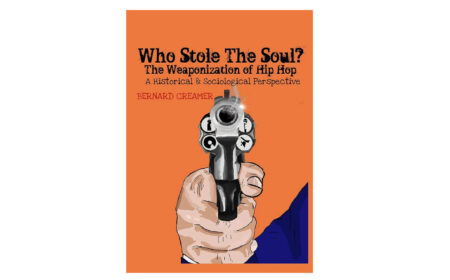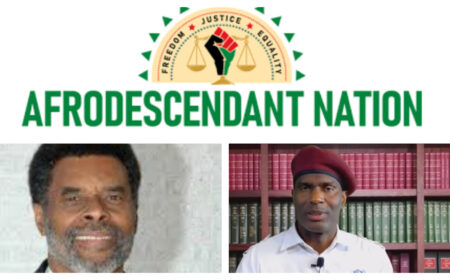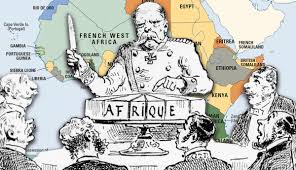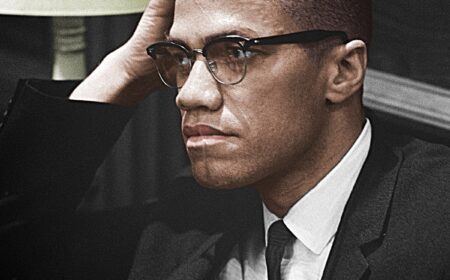As Black Activists Protested Police Killings, Homeland Security Worried They Might Join ISIS

Alice Speri
The Intercept
April 8 2019, 8:23 a.m.
As nationwide protests against police killings of black men began rolling across the country in 2014, federal and local law enforcement who were closely monitoring protesters’ online activities repeatedly expressed a bizarre concern: that the mostly black activists demanding an end to police violence in the U.S. might join with Islamic fundamentalist groups promoting violence abroad.
That concern was unequivocally baseless, and no evidence ever emerged to substantiate it. Still, documents obtained by the government transparency group Property of the People, which were shared exclusively with The Intercept, reveal that officials with the Department of Homeland Security and the Office of the Director of National Intelligence exaggerated the significance of isolated social media activity, mostly by foreign accounts, advocating for a connection between the domestic movement against police brutality and foreign terrorism.
In intelligence reports and internal communications circulated around the time of the protests in Ferguson, Missouri, and the 2015 Baltimore protests following the death in custody of Freddie Gray, DHS officials fretted that the Islamic State might attempt “to use the situation in Ferguson as a recruitment tool” or call on “Baltimore rioters to join them.” And in July 2016, during nationwide protests against the police killings of Philando Castile and Alton Sterling, the Office of the Director of National Intelligence, a cabinet position, circulated a memo warning that a lone, foreign pro-Al Qaeda Facebook user sought to seize on the protests to urge “‘Black’ Americans to take up arms” and “start armed war against the US government.
A Fixation Born of Bias
These official warnings that U.S. activism against police violence might be exploited as a recruitment opportunity by violent foreign terrorist groups slightly preceded the FBI’s designation of a “Black Identity Extremist” domestic terrorism category, which essentially cast large numbers of the same black activists as potential homegrown violent extremists. As The Intercept has reported, the FBI’s “Black Identity Extremism” label, while first used in a 2017 threat assessment report, originated on the heels of the Ferguson protests, and the first individual the FBI designated as a “black identity extremist” was a young Ferguson protester the agency had entrapped. But just as there is no evidence that a “Black Identity Extremist” ideology actually exists, there is also no evidence that U.S. activists ever saw or in any way responded to sporadic social media calls to join foreign fundamentalist Islamic groups.
If anything, critics say, law enforcement’s fixation on that nonexistent connection is testimony to both their anti-black and anti-Muslim bias.
“They try to make it more scary, it’s like, ‘If we link Islam to it, and we link Muslims to it, then people will see this as a real threat, because nothing is scarier than Muslims,’” Umar Lee, a well-known St. Louis activist, who is Muslim, told The Intercept, referring to the movement for black lives that started in Ferguson. “Nothing is scarier than, ‘Hey, if the Muslims get together with these scary black dudes, then we got a real problem, so we need every resource available to stop this.’”
“They already have a massive amount of funding to do quote unquote counterterrorism and Countering Violent Extremism, and all these other things that they do,” Lee noted, referring to well-funded domestic intelligence initiatives that have primarily targeted U.S. Muslims. “And they come up empty because the reality is that there are very few, hardly any people that are engaged in these activities.”
Civil rights advocates maintain the documents’ message is both baseless and dangerous.
“Blackness and Muslim identity have been cast as threatening since America’s founding,” said Omar Farah, a senior staff attorney at the Center for Constitutional Rights, which sued the FBI and DHS to obtain more information about its surveillance of black activists. “No surprise, then, that these documents reveal near obsessive fear of their intersection.”
“It’s inflammatory,” echoed Nusrat Choudhury, deputy director of the American Civil Liberties Union’s Racial Justice Program. “Just because members of foreign organizations are calling on domestic protesters to join their movements, that does not show those people in the United States are posing any threat of violence.”
The ACLU, which together with the Center for Media Justice also sued the FBI to obtain more information about the secretive “Black Identity Extremism” label, warned that casting individuals who express legitimate grievances as “extremists” risks exposing them to police harassment and stifling a movement that is badly needed. “There are long-standing, deep, structural, racial injustices in America, and people are allowed to call on this country to do better,” Choudhury said. “They’re allowed to do it under our Constitution, and frankly we need them to do it, because that is what has always led to racial justice in America.”
The Office of the Director of National Intelligence did not respond to a request for comment from The Intercept. DHS declined to comment on the record.
Fictional Connections to International Terrorism
The documents obtained via public records requests by Property of the People supplement similar documents previously made public by CCR and the racial justice group Color of Change. The earlier set of documents includes Islamophobic press coverage shared by DHS officials during the Baltimore protests, such as a Fox News story claiming that “Muslim groups seek to co-opt Ferguson protests” and an op-ed warning that the Islamic State, “which has stunned the world for its filmed beheadings and abuse of non-Muslims, is looking to capitalize on growing racial tension in the American city by claiming there is ‘no difference between black and white’ in their society.” It also includes an FBI situation report, issued less than two weeks into the Ferguson protests, warning that “ISIS supporters are urging Ferguson protestors to embrace radical Islam and engage in further violence. They are also reportedly telling any ISIS supporters in the US to travel to Ferguson.”
“Senior federal law enforcement assessing hysterical tabloids about ISIS co-opting the Ferguson protests is foolish,” said CCR’s Farah. “It would be comical if there weren’t dangerous implications for people of color and Muslims who speak out for justice only to be met with militarized police responses.”
The new set of documents, a selection of which The Intercept is publishing with this story, includes more internal assessments and emails exchanged by federal and law enforcement officials between 2014 and 2016.
In a partially redacted document marked for “DHS internal use only,” circulated days after a grand jury in Missouri declined to indict officer Darren Wilson for Brown’s killing, officials warned that “a purported fighter with the Islamic state, posted two images earlier today regarding Ferguson calling for the protesters to swear loyalty to the Islamic State.” The document also noted that the images were “making their rounds on English-language support accounts for the Islamic State,” though it made no mention of whether anyone affiliated with the Ferguson protests actually saw or responded to them.

DHS Office of Intelligence and Analysis Ferguson Protests November 20142 pages
In another redacted DHS intelligence document, released at the height of the 2015 Baltimore protests, officials warned that the account of a “presumed USPER,” a term used by intelligence officials to refer to U.S. citizens and residents, had called upon “‘indigenous peoples’ of the Americas and ‘Afro-Americans who are oppressed’ to attack ‘Anglo-American supremacists.’” The report continued: “There were multiple references to the riots in Ferguson, Missouri which was likely designed to resonate with an audience wider than [redacted name] has typically targeted. The messaging reflects
[redacted name’s]
awareness of recent US media coverage of perceived racial and other issues in American society, which the group is trying to exploit.” As in the earlier case, this assessment, too, offers no indication that anyone involved with the protests actually saw the posts.
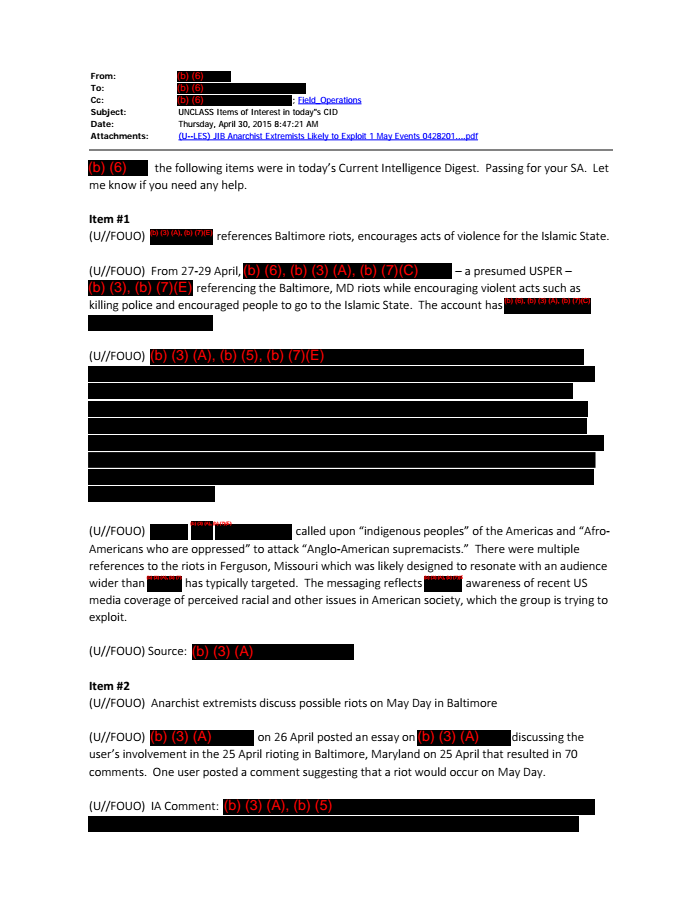
DHS Office of Intelligence and Analysis Baltimore Protests May 20152 pages
In December 2015, in Minneapolis, following the police killing of Jamar Clark, DHS posted a report indicating that it was closely watching the social media accounts of a number of people, and noted that one user “expresses support for Islamic State” and another posted a photo revealing an “Islam Is Life” tattoo. DHS again reported that a “US person posted a call for Islamic State support” in July 2016, days after the police killings of Philando Castile and Alton Sterling.
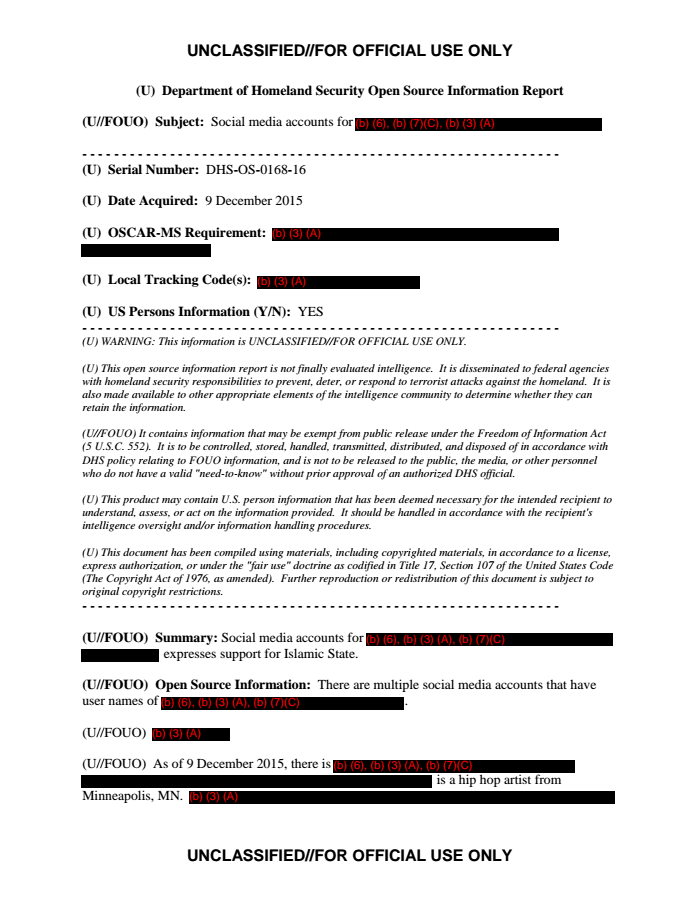
DHS Open Source Information Report December 20157 pages

DHS Open Source Information Report July 20162 pages
Shortly after that, as the deaths of Castile and Sterling were followed by deadly attacks on police officers in Dallas and Baton Rouge, the Office of the Director of National Intelligence issued a warning based on the Facebook posts of a Bangladesh-based Al Qaeda supporter. The user called on black Americans to draw inspiration from Micah Johnson, who on July 7 had killed five police officers and injured several others at a protest against police brutality in Dallas. “Like the Dallas attacker in US, we appeal to the other negro Americans to jump into the agitation to realize their rights,” the user wrote, according to the intelligence memo. “Pick up arms, like this attacker, against the terrorist US Armed Forces. Fight for your rights.”

Office of the Director of National Intelligence July 20162 pages
The reports quickly trickled down to local law enforcement and fusion centers across the country. In a July 2016 assessment by the Greater Cincinnati Fusion Center, for instance, officials preparing for an upcoming NAACP convention in that city warned that “FTOs such as the self-proclaimed Islamic State of Iraq and the Levant (ISIL) and al-Qa’ida in the Arabian Peninsula, have encouraged HVEs to conduct attacks within the Homeland,” the memo noted, using acronyms for Foreign Terrorist Organizations and Homegrown Violent Extremists. “These groups use social media to inspire and urge violent extremists to attack targets in the Homeland, including mass gatherings such as the NAACP convention.”

Greater Cincinnati Fusion Center Field Analysis Report July 20167 pages
That assessment listed a number of potential threats to the gathering and included references to a series of recent incidents of white supremacist violence specifically targeting African-Americans. But it also included much vaguer warnings that “ISIL” had recently “released an audio message urging its supporters to launch lone wolf attacks against military and civilian targets within the Homeland.” Theodore Sampson, a member of the fusion center and captain with the Hamilton County Sheriff’s Office, wrote in a statement to The Intercept that the threat assessment, conducted in partnership with DHS, was “intended to support the security and public safety efforts of government agencies and private sector partners in identifying, deterring, preventing, and responding to potential threats during the convention” and that such “threat assessments are designed to look objectively at potential threats towards an event or venue without bias.”
“In 2016, foreign terrorist organizations such as the Islamic State of Iraq and the Levant (ISIL) and al-Qa‘ida in the Arabian Peninsula had repeatedly called for homegrown violent extremists to conduct attack within the United States. This messaging was published in al-Qa’ida’s magazine Inspire and ISIL’s Dabiq publication and recordings sent our through the internet and radio. Additionally, these terrorist organizations and sympathizers utilized social media to encourage attacks within the Homeland,” Sampson wrote. “In this particular threat assessment, the reference to the audio message was to illustrate a recent example of the messaging encouraging lone wolf attacks towards mass gathering events and point out that homegrown violent extremist attacks were a persistent threat to mass gathering events.”
The NAACP, which last month requested that Congress hold hearings on domestic terrorism and “the ways in which Black activists are being tracked and monitored by government agencies,” could not immediately be reached for comment.
Absent from all these documents is any evidence that anyone associated with protests in the U.S. had responded to the exhortations of Islamic extremists — or that they had ever even seen those calls in the first place. Still, law enforcement’s close scrutiny of these isolated instances, even when none of them seem to have amounted to anything more substantial than social media posts, and the fact that these calls were prominently included in intelligence assessment reports, risked conflating, in the eyes of law enforcement, legitimate domestic protest with foreign terrorism.
Ryan Shapiro, Property of the People’s executive director, noted that government efforts to denigrate domestic critics by associating them with foreign enemies was an old and tested repressive tactic. “Since even before the FBI was named the FBI, U.S. intelligence agencies have preposterously targeted progressive dissent at home as tied to enemies abroad,” he told The Intercept. “Today’s obscene attempts to link Black Lives Matter to ISIS and Al Qaeda stand on the shoulders of a century of similar efforts to tar American dissent, especially in struggles for racial justice, as fronts for enemy agents.”
Shapiro also noted that the documents showed a propensity by federal law enforcement to base their “open source” intelligence-gathering on the conspiracy theories of conservative news outlets, which officials uncritically circulated during the protests. In addition to Islamophobic coverage, DHS officials shared during the Ferguson and Baltimore protests, for instance, in July 2016 the Office of the Director of National Intelligence circulated news stories, by Fox News and the U.K. tabloid Daily Mail, about a photo posted on Facebook in the aftermath of the Dallas killings that showed “a man dressed in black slashing a uniformed officer’s throat with a knife as blood spills out of the cop’s neck.” By contrast, earlier that summer, DHS officials monitoring protests in Minneapolis had also shared a story by the liberal publication AlterNet revealing that a local police union leader who had called Black Lives Matter a “terrorist organization” had a history of racist attitudes and was connected to a “white power-linked” bike gang. In that case, however, the officer circulating the story added a comment: “This article sounds like a drummed up hit piece to me,” the officer wrote. “But it’s nonetheless interesting to see all the race-related drama in Minneapolis at the moment.”
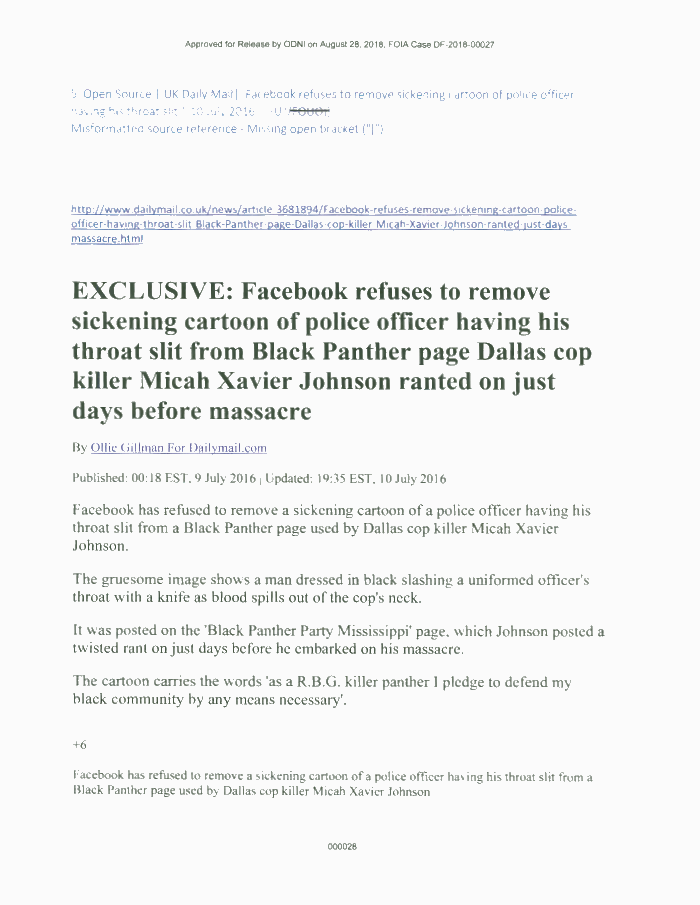
Office of the Director of National Intelligence Press Clippings July 20167 pages
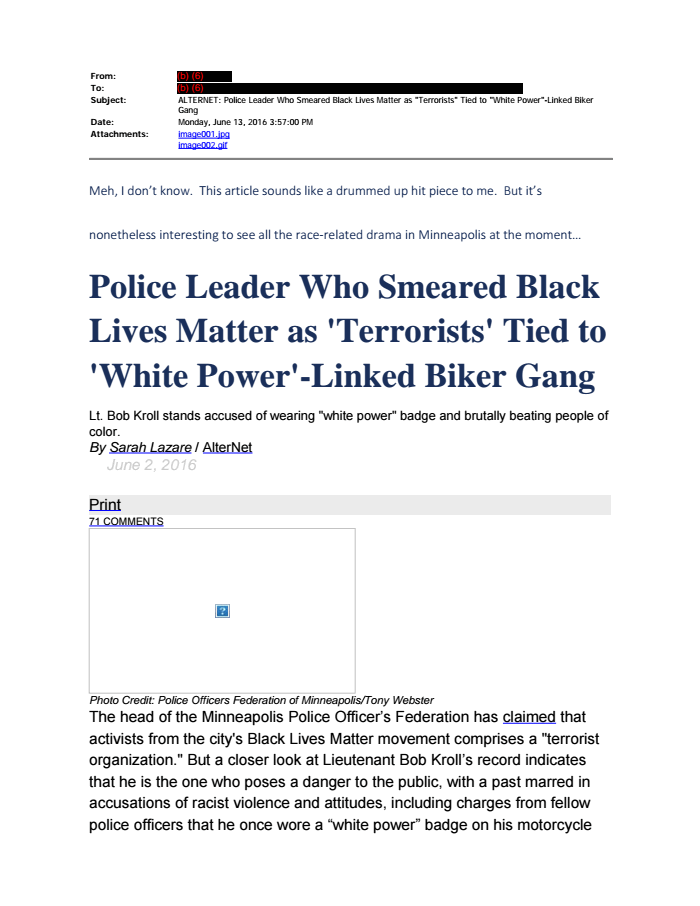
DHS Press Clippings June 20166 pages
“Homeland Security is basing terrorist intelligence assessments of Black Lives Matter on articles from Fox News and a British tabloid that literally warns of the great menace posed by Putin’s purported army of hypnotic, shapeshifting super squid,” said Shapiro, referring to DHS officials sharing a report about Islamic State members calling on black protesters to join them by the U.K.’s Daily Express, which also published a particularly outlandish story about the Russian president. “Meanwhile,” Shapiro added, “DHS and other U.S. agencies are contorting themselves to ignore clear evidence of the dire threat from the far right.”
Exposing Activists to Serious Risk
Federal officials weren’t the only ones seeking to associate domestic dissent to foreign terrorism. Starting in Ferguson, a number of elected and law enforcement officials across the country referred to protesters not only by using racist terms such as “thugs,” but also, increasingly, by calling them “terrorists,” a reference that the FBI’s “Black Identity Extremism” report only seemed to validate.
Indigenous and environmental rights activists involved in the Standing Rock protest movement were also repeatedly characterized as “terrorists.” As The Intercept reported, private security contractors hired by the oil company behind the Dakota Access pipeline referred to the peaceful protest movement born to oppose the pipeline as a “jihadist insurgency” — and routinely shared intelligence assessments with law enforcement that portrayed activists as dangerous threats.
At Standing Rock, as in Ferguson, those watching the growing protests also paid particular attention to displays of solidarity with Palestine, with private security in North Dakota, for instance, noting that “the presence of additional Palestinians in the camp, and the movement’s involvement with Islamic individuals is a dynamic that requires further examination.”
“To them, a Palestinian flag might as well be an ISIS flag,” said Lee, the Ferguson activist, referring to the baseless conflation of the Palestinian struggle with Islamic extremism.
“It wouldn’t shock me at all to see misinterpretation of symbols,
conflation of different groups, of different racial and ethnic and
political and religious backgrounds, under this vector of challenging a
Muslim boogeyman,” echoed Choudhury. “It’s absurd.”
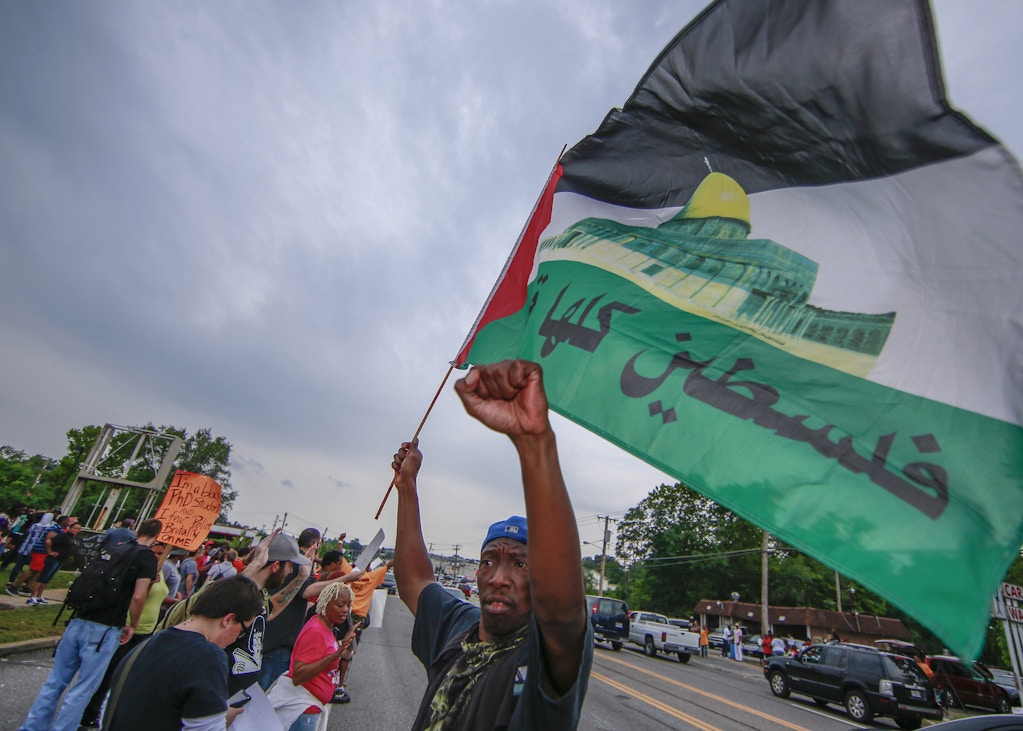
A protester waves a Palestinian flag in solidarity with Gaza during a demonstration after the shooting death of Michael Brown in Ferguson, Mo., on Aug. 16, 2014.
Photo: Bilgin Sasmaz/Anadolu Agency/Getty Images
Choudhury, who for years has worked to expose an FBI “racial and ethnic
mapping program,” noted that following the 9/11 attacks, the ACLU has
obtained a number of intelligence documents that revealed the
surveillance of Muslim, Arab, Middle Eastern, and South Asian groups,
premised on what she called a “totally unsubstantiated” recruitment
threat from foreign Islamist groups. The ACLU, she added, also exposed
intelligence training material filled with racial stereotypes about
people of Arab descent and Muslims, showing the agency’s profound
ignorance about the very people it was surveilling.
But while there was never any evidence that foreign extremists’ isolated appeals to U.S. activists had any effect, critics said the mere suggestion exposed those activists to serious risk.Join Our NewsletterOriginal reporting. Fearless journalism. Delivered to you.I’m in
“That is the inevitable result of the creation of such a flawed intelligence product, that it inspires fear, and that it is going to lead to federal and state and local law enforcement’s targeting of black activists based on nothing close to wrongdoing or violence,” said Choudhury. “It’s very dangerous, because it leads to this kind of targeting of human beings here in America, who are calling for equality and justice, just because there are other threats abroad.”
Lee, the St. Louis activist, said that during the Ferguson protests, online trolls and conservative commentators especially targeted him and a couple of other Muslim activists with smear campaigns and racist and Islamophobic attacks, calling them terrorists and suggesting they were affiliated with Al Qaeda. One such smear, picked up widely by right-wing blogs, accused Lee of “threatening to behead critics.”
“Some of those people were spreading rumors that I was in Ferguson recruiting for ISIS,” Lee told The Intercept, noting that even some fellow protesters, when he once joined a protest right after leaving his mosque and while still wearing a thobe, commented “Here comes ISIS.”
But Lee put the blame for smears and harassment campaigns squarely on government-sanctioned racism. He also pointed to the recent vilification of the black and Muslim Congressperson Ilhan Omar as another example of how ignorant and hate-filled campaigns are enabled by official discourse — whether by law enforcement and intelligence agencies or by lawmakers themselves. “It’s institutionalized Islamophobia,” Lee said. “It’s institutionalized crusader mentality.
READ MORE AT: https://theintercept.com/2019/04/08/black-protesters-terrorism-threat-isis/
